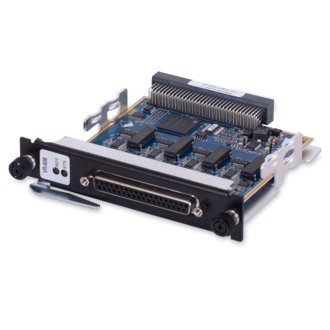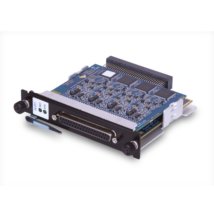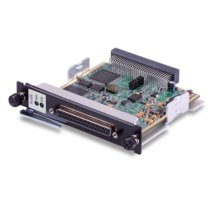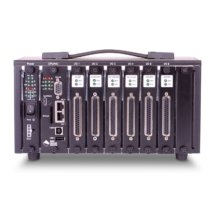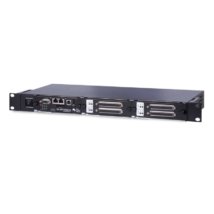The DNR-VR-608 is an 8-channel, variable reluctance sensor interface board, compatible with UEI’s RACKtangel™. The DNA/DNF-VR-608 is compatible with UEI’s Cube and FlatRACK chassis respectively. Electronically, they are identical. The boards are designed for use in a wide variety of motion and rotation monitoring applications. Each channel provides a fully differential input and is capable of monitoring VR output levels as high as 250 Volts peak-to-peak. The board is also an ideal solution as a general counter unrelated to variable reluctance sensors and can be used to measure an extremely wide variety of AC signals.
The DNx-VR-608 offers a maximum input pulse rate of 300 kHz. The maximum input pulse rate is somewhat dependent on the signal level. The detailed specs to the right show pulse rates obtainable at different input signal levels. The minimum detectable input signal may be fixed at 50 mVp-p or may be set to “Adaptive Peak Threshold” mode where the threshold is set at approximately 30% of a time averaged input.
A watchdog circuit resets the input to minimum threshold level if the input “drops out” for 85 mS. Open sensor/disconnected cable detection is also provided on the VR-608 board.
The DNx-VR-608 supports the following operating modes:
- Timed Count/Frequency: Counts the number of teeth detected during a specified time interval
- N pulses: Measure the time taken to detect N teethl
- Z/Index pulse: Measure the number of teeth and the time elapsed between two Z/Index pulses (The Z/Index tooth is usually a gap or a double tooth on the encoder wheel)l
- Quadrature Decoder: Even and Odd channels are used in pairs to determine direction and positionl
- Inter-tooth time: For those looking to measure at very low rates and/or to track acceleration between teeth, a powerful intertooth timing function is available. This function measures the time differential between teeth with a resolution of 15.2 nS at a counter depth of 32 bits. Each measurement is stored in a FIFO, so acceleration profiles over the entire input operating range can be acquired for indefinite periods.
The input impedance of each channel is greater than 40 kOhms with less than 250 pF of capacitance. This high impedance ensures the board is compatible with an extremely wide range of variable reluctance sensors.
The DNx-VR-608 is fully isolated from the UEI chassis as well as other I/O boards installed in the chassis. In addition, the inputs are divided into four sets of channel pairs, and each two-channel pair is isolated from the others. Each isolated channel pair is also supported with a logic level digital output.

